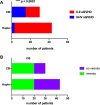Co-Transplantation of Haploidentical Stem Cells and a Dose of Unrelated Cord Blood in Pediatric Patients with Thalassemia Major
- PMID: 33593080
- PMCID: PMC7894585
- DOI: 10.1177/0963689721994808
Co-Transplantation of Haploidentical Stem Cells and a Dose of Unrelated Cord Blood in Pediatric Patients with Thalassemia Major
Abstract
Allogeneic stem cell transplantation is a cure for patients suffering from thalassemia major (TM). Historically, patients were limited by the selection of donors, while the advancement of haploidentical stem cell transplantation (haplo-SCT) has greatly expanded the donor pool. However, the outcomes of haplo-SCT in TM recipients vary between different programs. In this study, we retrospectively studied 73 pediatric TM patients (median age, 7 years; range, 3 to 14 years) who underwent haplo-cord transplantation. Both the estimated overall survival and transfusion-free survival were 95.26% (CI 95.77% to 96.23%). Neither primary nor secondary graft failures were observed. The median follow-up period was 811 days (range, 370 to 1433 days). Median neutrophil and platelet engraftment times were 22 days (range, 8 to 48 days) and 20 days (range, 8 to 99 days), respectively. Acute graft-versus-host disease (aGVHD) was observed in 52% of patients and of these, 25% developed grade III to IV aGVHD. Cord blood engraftment was associated with delayed immune recovery and increased aGVHD severity. Viral DNAemia occurred in a relatively high proportion of patients but only 7% of patients developed CMV disease, while another 7% of patients had post-transplantation lymphoproliferative disorder. Long-term complication outcomes were good. Only one patient developed extensive chronic GVHD. No surviving patients were reliant on blood transfusion by the time this manuscript was submitted. This is one of the largest studies on the outcomes of pediatric TM patients who received stem cell transplantations from alternative donors. The haplo-cord program is safe and practical for TM patients that do not have matched donors.
Keywords: cord blood transplant; haploidentical stem cell transplantation; thalassemia.
Conflict of interest statement
Figures



Similar articles
-
Hematopoietic stem cell transplantation for homozygous β-thalassemia and β-thalassemia/hemoglobin E patients from haploidentical donors.Bone Marrow Transplant. 2016 Jun;51(6):813-8. doi: 10.1038/bmt.2016.7. Epub 2016 Feb 15. Bone Marrow Transplant. 2016. PMID: 26878659 Free PMC article.
-
Haplo-Cord transplantation compared to haploidentical transplantation with post-transplant cyclophosphamide in patients with AML.Bone Marrow Transplant. 2017 Aug;52(8):1138-1143. doi: 10.1038/bmt.2017.36. Epub 2017 Mar 27. Bone Marrow Transplant. 2017. PMID: 28346415
-
Outcome of haploidentical versus matched sibling donors in hematopoietic stem cell transplantation for adult patients with acute lymphoblastic leukemia: a study from the Acute Leukemia Working Party of the European Society for Blood and Marrow Transplantation.J Hematol Oncol. 2021 Apr 1;14(1):53. doi: 10.1186/s13045-021-01065-7. J Hematol Oncol. 2021. PMID: 33794963 Free PMC article.
-
Alternative donor transplantation--"mixing and matching": the role of combined cord blood and haplo-identical donor transplantation (haplo-cord SCT) as a treatment strategy for patients lacking standard donors?Curr Hematol Malig Rep. 2015 Mar;10(1):1-7. doi: 10.1007/s11899-014-0245-y. Curr Hematol Malig Rep. 2015. PMID: 25667129 Review.
-
Haplo-cord transplant. Realizing the potential of umbilical cord blood grafts. - A review of techniques and analysis of outcomes.Leuk Lymphoma. 2024 Oct;65(10):1384-1397. doi: 10.1080/10428194.2024.2361353. Epub 2024 Jul 1. Leuk Lymphoma. 2024. PMID: 38949786 Review.
Cited by
-
[Chinese guideline for diagnosis and treatment of transfusion dependent β-thalassemia (2022)].Zhonghua Xue Ye Xue Za Zhi. 2022 Nov 14;43(11):889-896. doi: 10.3760/cma.j.issn.0253-2727.2022.11.002. Zhonghua Xue Ye Xue Za Zhi. 2022. PMID: 36709178 Free PMC article. Chinese. No abstract available.
References
-
- John MJ, Jyani G, Jindal A, Mashon RS, Mathew A, Kakkar S, Bahuguna P, Prinja S. Cost effectiveness of hematopoietic stem cell transplantation compared with transfusion chelation for treatment of thalassemia major. Biol Blood Marrow Transplant. 2018;24(10):2119–2126. - PubMed
-
- Mohamed SY. Thalassemia major: transplantation or transfusion and chelation. Hematol Oncol Stem Cell Ther. 2017;10(4):290–298. - PubMed
-
- Xu LP, Wu DP, Han MZ, Huang H, Liu QF, Liu DH, Sun ZM, Xia LH, Chen J, Wang HX, Wang C, et al. A review of hematopoietic cell transplantation in China: data and trends during 2008-2016. Bone Marrow Transplant. 2017;52(11):1512–1518. - PubMed
Publication types
MeSH terms
LinkOut - more resources
Full Text Sources
Other Literature Sources

